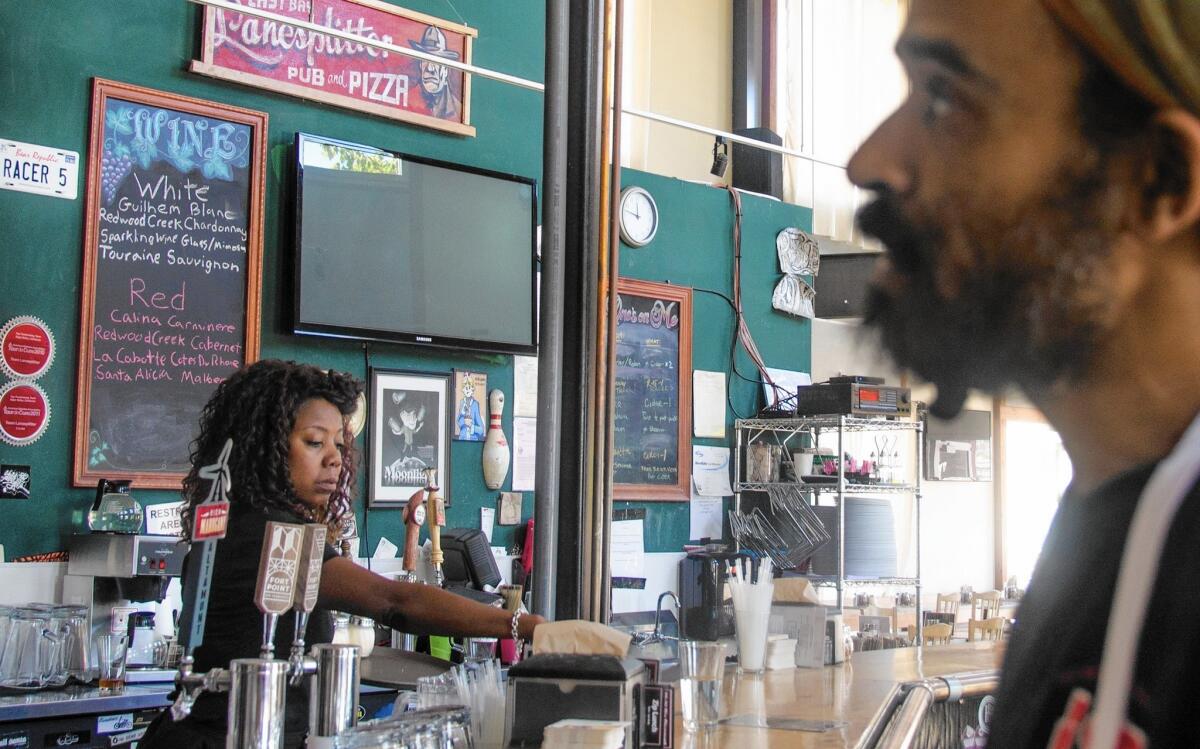A minimum wage arms race has broken out in the Bay Area

Vic Gumper and a buddy opened their first pizzeria in Berkeley nearly 18 years ago, expanding to Oakland, Albany and this 1.1-square-mile city best known for Pixar Animation Studios, big-box retailers and a biotech cluster.
Over the years, die-hard patrons of his business have crafted personalized dolls of each Lanesplitter Pizza & Pub employee, which adorn the walls in glass cases, as does one customized Monopoly board. (“Too much Black Sabbath on the CD player. Pay $15.”)
And, since April, along with newly printed menus, every table sports a laminated card explaining just what a “living wage pizza” means.
All workers now earn $15 to $25 an hour as part of an experimental business model that also did away with gratuities and raised prices, making meals at all five locations “sustainably served, really … no tips necessary.”
Gumper took the plunge after Berkeley, Oakland and San Francisco increased their minimum wages, and Emeryville’s council members were poised to leapfrog the others with a massive boost to $14.44 per hour, the nation’s highest.
NEWSLETTER: Get the day’s top headlines from Times Editor Davan Maharaj >>
That wage went into effect last month, though businesses with fewer than 56 workers, like Gumper’s restaurant here, started on par with Oakland’s $12.25 and, as in San Francisco, will hit $15 per hour by 2018.
“This movement, it’s going on everywhere,” said Gumper, 45, who would have triggered mutiny, not to mention bookkeeping hell, by paying different wages at different locations. “We just decided to manage the situation and get to a place where we can sustain it.”
The push for a $15 hourly wage has made strides nationwide, beginning in Seattle. Los Angeles city and county recently approved the phased-in wage. And a New York state wage board has recommended that fast-food workers edge up to the target.
But the changes have come particularly fast to the liberal Bay Area, now known for the highest cost of living in the nation.
“It takes a lot of stress out of my life,” said Don Fletcher, 50, who saw his wage as a security guard in Emeryville jump last month from $11.50 an hour to $14.44. Before, he added, “I had to make a lot of efforts to cut corners, acquiring food as cheaply as possible. And any expenses like car repairs would require several months of strategizing and saving.”
Still, it is not yet clear how the patchwork of increases will play out, as businesses in low-profit sectors scramble for solutions to the rise in expenses, consumers confront higher costs and workers with boosted wages flex some new spending power.
There are plenty of critics.
“A lot of people out there have this belief that businesses are all run by guys with top hats lighting cigars with $100 bills,” said 48-year-old Brian Hibbs, self-titled “Head Cheese” of San Francisco’s Comix Experience, which he founded at age 21.
“The problem is … your local bookstore, local burrito store, they are not a multinational corporation,” he said. “Raising the minimum wage to $15 is essentially legislating that as a business you have to make X or else you’re not a real business. … It’ll mean there will be less jobs for people.”
Hibbs felt doomed when San Francisco voters backed the increase to $15. Like other bookstores, “the product we sell has a price printed directly on it,” he noted, and can’t be raised without losing even more business to Amazon.
But, to the relief of his workers and customers, he came up with a plan: to sell monthly memberships to a “graphic novel club” whose benefits include a curated graphic novel of the month, a social gathering to discuss it, access to private author events and other swag.
Gumper has also earned kudos from patrons for his innovation, but some have recoiled from paying $30 or more for a pizza. He has seen a 25% drop in sales over the last few months and has had to eliminate lunch hours at some locations.
“The necessity of paying people a living wage in the Bay Area is clear, so it’s hard to argue against it, and it’s something I’m really proud to be able to try doing,” he said. “At the same time, I’m terrified of going out of business after 18 years.”
San Francisco and Santa Fe were the first cities to boost their minimum wages a dozen years ago. After a lull, voters in San Jose and Albuquerque followed suit in 2012. But a $15 hourly minimum wage was nowhere on the table.
Last year, the movement took off here as housing costs soared.
Berkeley’s City Council approved a hike in June 2014 that will lift the minimum wage to $12.53 by next year. In November, voters in San Francisco and Oakland overwhelmingly approved increases, with San Francisco on track to hit $15 before Seattle does. Oakland went up to $12.25 this year.
As Emeryville one-upped its neighbors, Berkeley sent its labor commission back to the drawing board. The council next month is expected to take up a proposal that would add paid sick days, extend wage hikes until they hit $19 in 2020 and then add cost-of-living increases in perpetuity.
Jennifer Lim is deputy director of the East Bay Alliance for a Sustainable Economy, which convened the coalition that pushed increases in Oakland and Emeryville. Two years ago, she said, “a $15 minimum wage was unthinkable. Now it’s unstoppable.”
In the push for a regional standard, little Emeryville has emerged as an important player.
Situated at the base of the Bay Bridge, the city has 10,000 residents — but twice as many workers. It has been called the “mall of the Bay Area … Apple and the Gap, Home Depot and IKEA all have a presence in Emeryville,” Lim said, “so it’s kind of a microcosm.”
SIGN UP for the free California Inc. business newsletter >>
Mayor Ruth Atkin was involved when hotel workers here won higher wages with a successful 2005 ballot measure, and a year later, when the city implemented a living wage for municipal workers and contractors. As she brainstormed with others last year, she recalled thinking, “What purpose is a living wage if it isn’t a living wage?”
------------
FOR THE RECORD
Aug. 18, 9:56 a.m.: This article quotes Emeryville Mayor Ruth Atkin as saying, “What purpose is a living wage, if it isn’t a living wage?” Her quote was: “What purpose is a minimum wage, if it isn’t a living wage?”
------------
The jump to $14.44, which tracks with what city employees now earn, was calculated as necessary to get full-time workers off public assistance. Smaller businesses were granted the $12.25 starting point after several dozen lined up at a City Council study session in April to express concerns at the pace of change.
At Lanesplitter, some kitchen workers got a significant bump, while some servers accustomed to getting cash tips aren’t so sure they like the new system.
Nina Gates, 44, recently left a high-tipping bar job in San Francisco to move closer to her ailing mother in Oakland. She found “the smallest studio you’ve ever seen” for $1,400 a month. As a new server, she earns $16.25 per hour with a chance for bonuses based on sales. But she misses her cash tips and isn’t coming close to her former pay.
Gumper gets it, but says he had no choice but to radically rework his approach and incorporate increased costs into his pricing, something a handful of other higher-end Bay Area restaurants have also done.
San Francisco’s Hibbs said he, too, had to innovate or die.
He was at a community meeting early this year for Borderlands, a Mission District science fiction bookstore that had announced it would have to close because of the wage measure, when one of his regular customers suggested he turn his weekly bookstore social events into sales opportunities.
“A little cartoon light bulb went off in my head,” he said.
Hibbs later calculated that he could cover the costs of a $15 wage if he sold 334 memberships to the graphic novel club at $20 per month. Meanwhile, Borderlands’ owner was persuaded by fans to let them contribute with sponsorships, and the store remains open.
Hibbs has only 99 more memberships to sell over the next few years, but he believes consumers will balk if too many retailers offer such add-ons. Nevertheless, he is relieved.
“I came up with a cool plan,” he said, “and it worked.”
Twitter: @leeromney
ALSO:
Happy trays: A renovated Clifton’s cafeteria is set to reopen after nearly four years
Companies hope cybersecurity experts in the boardroom can counter hacks
Machine ‘learners’ compute cloud cover to balance power supplies







